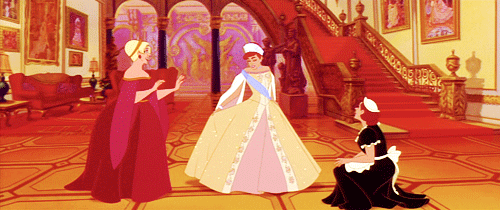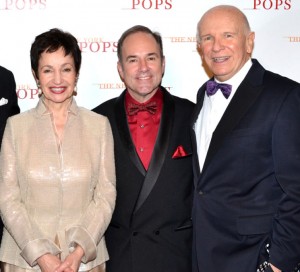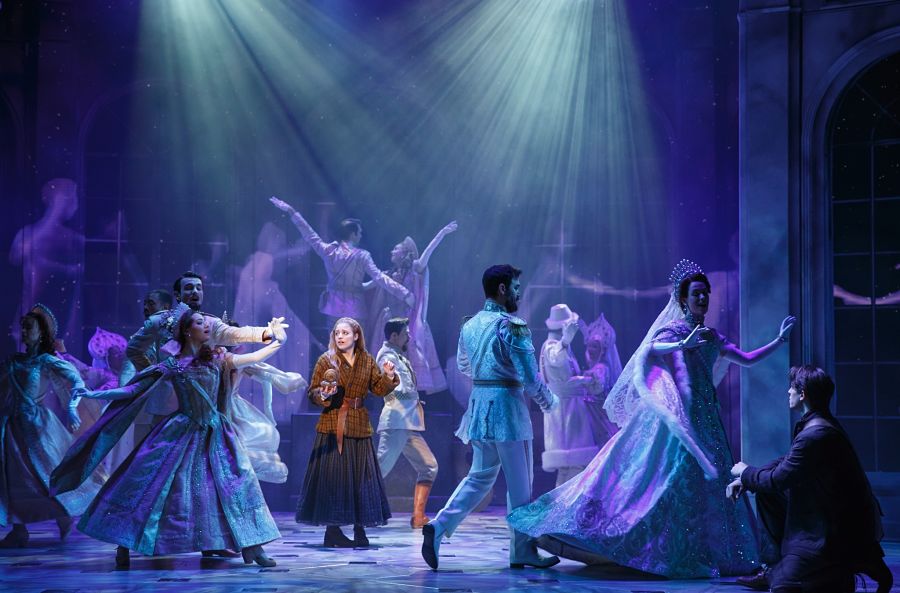HARTFORD, CONN.: Early on in the 1997 animated film Anastasia, a young amnesiac woman leaves the orphanage where she was raised and decides to travel to St. Petersburg to find family and a life she can’t remember. She sings a song about overcoming her fears called “Journey to the Past.” In the new stage adaptation of the film, currently in its world premiere at Hartford Stage through June 19, none of the lyrics are different. But this time Anya, as she is called, doesn’t sing it until the end of Act One, when she arrives in Paris to learn whether she really is the Grand Duchess Anastasia. Liz Callaway memorably sang it in the movie (Aaliyah also recorded a pop version); but in the new stage version, Christy Altomare makes it her own, hitting the notes to make it a powerful first-act closer.
“We felt that she couldn’t be that strong, character-wise, until the end of Act One, so that song was moved,” says composer Stephen Flaherty, explaining the reordering. Anya still has an opening song, but it’s a new one called “In My Dreams,” written by Flaherty and his longtime lyricist partner Lynn Ahrens (Ragtime, Rocky, Suessical). The new song, says Flaherty, is “about her and her memories and trying to find her way through the dark to unlock her own identity, and that felt much more appropriate.” Most importantly, by not starting at such a high pitch of emotion, it gives the character somewhere to go.
Another reason for the change: Book writer Terrence McNally wanted Act One to take place in Russia and Act Two in Paris, “which was everything modern Soviet Russia was not: free, expressive, creative, no barriers,” says McNally.
When a Russian producer approached Ahrens and Flaherty four years ago about adapting the animated film to the stage, they immediately thought of McNally; though the Russian production never came to fruition, it started the ball rolling. The musical team had collaborated with McNally previously on the epic Ragtime and the chamber musical A Man of No Importance; they thought of Anastasia as in some ways a cross between the two.
“It has a very intimate love story and a very touching and moving relationship between a grandmother and her grandchild, but it also has the sweep of history, and we thought Terrence could handle it all,” Ahrens says. McNally told them that he wasn’t interested in simply putting the movie onstage—which was the right answer, as they too were looking to rethink it. The lovely albeit historically inaccurate film was aimed at young audiences; now that Ahrens and Flaherty are older, as are the children who grew up loving the film, they wanted to take a more mature approach.
 On the one hand, Ahrens says, “I think we all tried very hard to honor the animation—we wanted it to be sparkly and beautiful and youthful and lots of fun.” But she and her collaborators also “wanted to make it richer and deeper.” Along the way, they cut some of the more outlandish characters from the film. Explains Ahrens: “It just seemed like if we didn’t do that we would be doing nothing more than transferring the animation to the stage, and we really wanted to be more adventurous than that.”
On the one hand, Ahrens says, “I think we all tried very hard to honor the animation—we wanted it to be sparkly and beautiful and youthful and lots of fun.” But she and her collaborators also “wanted to make it richer and deeper.” Along the way, they cut some of the more outlandish characters from the film. Explains Ahrens: “It just seemed like if we didn’t do that we would be doing nothing more than transferring the animation to the stage, and we really wanted to be more adventurous than that.”
For reference, McNally looked at both the animated film and the 1956 live-action film starring Ingrid Bergman. But he then set both aside and wrote his own version of the myth. He says he approaches musicals like plays, writing everything out, then giving the script to the songwriting team.
“I don’t leave blank spaces, which I think a lot of people who don’t write musicals think is what the librettist does: ‘She sings a love song now,'” says McNally. “No. You have to write a love scene, and then the composer and lyricist have to find the music and love lyrics in it.”
The basic story is the same as the film’s: In the aftermath of the Russian Revolution, amid the search for missing members of the deposed Romanov family, con men Dmitry (Derek Klena) and Vlad (John Bolton) find someone to pass off as the dispossessed princess Anastasia to collect the reward money from the Dowager Empress (Mary Beth Peil). Then they meet Anya, who complicates their plans—because she might actually be the real Anastasia.
The most notable absences from the stage version: the villain Rasputin and his talking bat Bartok.

“Rasputin died before the Russian Revolution, so that just bothered me too much historically to have left it in,” says McNally. The film got around this pesky anachronism by having Rasputin rise from the dead to hunt down Anastasia; but that wasn’t going to fly with McNally, and Ahrens and Flaherty were only too happy to welcome McNally’s new antagonist, Gleb, a Chekist police officer torn between the ideals of the Revolution and his attraction to Anya. Played with conviction and torment by Manoel Felciano, he is a much more dimensional villain than Rasputin was in the film, though Ahrens concedes that the creative team is still tinkering with the part.
“He’s an outsider to the central relationships—the girl and her grandmother, Anya and Dmitry, the countess and Vlad,” she says. “When he goes to find her in Paris, he doesn’t have anybody with him to talk to, and that’s tricky when you have to start writing internal monologues and figure out how he fits in.”
They’ll have some time to figure it out between now and next spring, when the show is reportedly slated for a Broadway run. Ahrens doesn’t take the out-of-town tryout for granted.
“It’s a delicate environment,” she says. “You’re working hard. You’re tired. You’re trying to get things right. And to have critics looming overhead immediately in New York is a very daunting process,” she says. “It’s really hard to get something 100 percent the first time out.”
Though all versions of this tale are essentially mythology, one way the stage version is more historically accurate than the film is that Anastasia is 17 when the Revolution starts, as opposed to being a little girl who, in the film, escapes from the palace with the help of a little kitchen boy, who turns out to be Dmitry.
“We just knew we weren’t going to do the little boy opening the secret door for her to escape,” says Ahrens. “That didn’t seem right with what we were doing, because we wanted to tell the whole Revolution in terms of movement and dance and the story of a girl becoming separated from her family.” Still they wanted to keep the Anya/Dmitry connection, so they wrote a sweet new song, “In a Crowd of Thousands,” that establishes the link, while also giving Klena and Altomare a chance to show off their chemistry.
It’s one of 16 new songs, in addition to the 6 kept from the movie, some with new or revised lyrics. Flaherty says that it was surprisingly effortless to return to a score after 20 years.

“I had done so much research originally that when it came time to do the new material, it actually just poured out,” he says. He was able to go deeper into Russian sounds this time around; he’s woven in some actual Tchaikovsky for a pivotal Act Two scene at the ballet. “I thought it would be really interesting if we could have some way to have the characters watching a performance of Swan Lake that would feature the music of Tchaikovsky, and have my own themes associated with our characters, and weave them vocally within the Tchaikovsky ballet music.” The director, Darko Tresnjak, and choreographer Peggy Hickey picked up on the idea, Flaherty says, and “found a way that the ballet would actually mirror what was happening psychologically to our characters.” The scene also provides a showcase for the visually stunning costumes by Linda Cho and set by Alexander Dodge, often enhanced by Aaron Rhyne’s video and projection design.
Ahrens reports that so far Fanastasias, as she affectionately calls Anastasia fans, seem pleased with the alterations.
“All of them were coming up to us and hugging us and kissing us and thanking us for keeping what they loved and making it even better now,” she says. “So we feel confident that we did the right thing.”
If no one cries “impostor,” maybe this Anastasia is the real princess after all.


